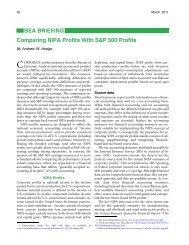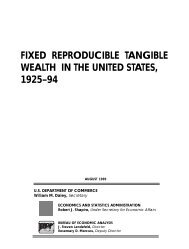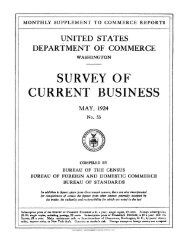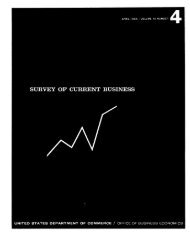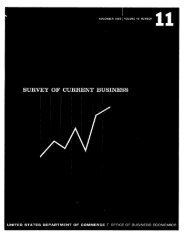current business statistics - Bureau of Economic Analysis
current business statistics - Bureau of Economic Analysis
current business statistics - Bureau of Economic Analysis
You also want an ePaper? Increase the reach of your titles
YUMPU automatically turns print PDFs into web optimized ePapers that Google loves.
February 1972 SURVEY OF CURRENT BUSINESS 25<br />
sumption remains high despite the U.S.<br />
withdrawal from Vietnam and the<br />
deactivation <strong>of</strong> a number <strong>of</strong> naval ships.<br />
However, large contracts for refined<br />
petroleum products which had previously<br />
been awarded to firms in foreign<br />
countries have recently been placed in<br />
Guam and the Virgin Islands. Defense<br />
purchases <strong>of</strong> refined petroleum products<br />
in U.S. territories are classified as<br />
domestic transactions and are thus<br />
excluded from the military account in<br />
the balance <strong>of</strong> payments <strong>statistics</strong>. Of<br />
course, any import <strong>of</strong> crude petroleum<br />
into Guam and the Virgin Islands, to<br />
be refined under such contracts, is<br />
recorded in the private merchandise<br />
account.<br />
Procurement <strong>of</strong> subsistence items<br />
abroad, amounting to over $65 million<br />
in 1970, represents another significant<br />
portion <strong>of</strong> total procurement <strong>of</strong> materials<br />
and supplies. Even in the jet<br />
age it is difficult to transport fresh fruit<br />
and vegetables from the United States<br />
to some <strong>of</strong> the remote spots <strong>of</strong> the world<br />
where U.S. forces are assigned. Contracts<br />
to supply subsistence items are<br />
an important source <strong>of</strong> foreign earnings<br />
for certain countries, and these contracts<br />
are <strong>of</strong>ten directly correlated with<br />
U.S. privileges at foreign bases.<br />
Various measures have been instituted<br />
to minimize defense procurement<br />
abroad and to press the use <strong>of</strong> U.S.<br />
materials and supplies in support <strong>of</strong><br />
U.S. defense activities overseas. Preference<br />
is accorded to domestic over foreign<br />
suppliers when estimated U.S.<br />
costs do not exceed foreign costs by<br />
more than 50 percent. During the<br />
1960's, however, accelerated military<br />
activity in Vietnam necessitated the<br />
placement <strong>of</strong> orders which could be<br />
filled quickly, and suppliers in Japan,<br />
Korea, Taiwan, and a few other countries<br />
enjoyed obvious geographical advantages.<br />
Certain <strong>of</strong> these contracts<br />
were placed in countries for support <strong>of</strong><br />
their forces deployed to the Republic<br />
<strong>of</strong> Vietnam, but large contracts were<br />
also let for support <strong>of</strong> U.S. forces.<br />
Military assistance program<br />
Offshore procurement for military assistance<br />
purposes continues to decline<br />
and amounted to only $4 million in the<br />
first half <strong>of</strong> 1971. Such procurement,<br />
once a major component <strong>of</strong> military<br />
spending abroad, consists mainly <strong>of</strong> the<br />
acquisition <strong>of</strong> military equipment to be<br />
given to foreign countries as military<br />
assistance grants. Other disbursements<br />
under the declining Military Assistance<br />
Program are contributions to international<br />
military headquarters expenses—<br />
about $25 million per year—and small<br />
amounts <strong>of</strong> administrative expenses.<br />
Geographic Distribution <strong>of</strong><br />
Defense Spending<br />
Under a complex system <strong>of</strong> treaties<br />
and bilateral agreements, the United<br />
States has deployed its troops virtually<br />
around the world. American forces continue<br />
to operate in South Vietnam and<br />
to man defense lines in South Korea;<br />
large garrisons are maintained in West<br />
Germany; a fleet patrols waters <strong>of</strong>f the<br />
Middle East, another cruises in the<br />
Western Pacific, and the navy stands<br />
ready to deploy ships to trouble spots.<br />
In spite <strong>of</strong> this far-flung network <strong>of</strong><br />
military facilities, defense outlays<br />
abroad are concentrated in relatively<br />
few countries.<br />
Germany continues to be the leading<br />
recipient, with expenditures there during<br />
the first half <strong>of</strong> 1971 amounting to<br />
$1.2 billion at an annual rate (table 2<br />
and chart 14). Nearly one-half <strong>of</strong><br />
these expenditures were made by U.S.<br />
personnel and by the system <strong>of</strong> PX's,<br />
and service and entertainment facilities<br />
which serve the American military<br />
community in Germany. Payments to<br />
foreign locally engaged staff run to<br />
more than $250 million annually and<br />
nearly $200 million is incurred for<br />
other services.<br />
A series <strong>of</strong> "<strong>of</strong>fset" agreements between<br />
the United States and the<br />
Federal Republic <strong>of</strong> Germany has<br />
been designed to neutralize a substantial<br />
portion <strong>of</strong> the balance-<strong>of</strong>-payments<br />
costs <strong>of</strong> maintaining U.S. forces in<br />
Germany. From 1962 through 1967,<br />
Germany deposited funds with the<br />
U.S. Treasury in amounts approximating<br />
our defense expenditures there.<br />
Such funds were earmarked for German<br />
purchases <strong>of</strong> military goods and services<br />
from the U.S. Government and from<br />
private U.S. firms. In the following 2<br />
years, the principal provision <strong>of</strong> the<br />
<strong>of</strong>fset agreements was the purchase <strong>of</strong><br />
medium-torn U.S. Government securi^<br />
ties by the Bundesbank. German deposits<br />
in the U.S. Treasury for purchases<br />
<strong>of</strong> U.S. military goods and<br />
services again became the major provision<br />
in the agreement covering fiscal<br />
years 1970 and 1971. Late in calendar<br />
1971, the United States and Germany<br />
concluded a new <strong>of</strong>fset agreement<br />
covering the period from July 1, 1971<br />
through June 30, 1973. Total provisions<br />
under the new agreement amount to<br />
about $2 billion, <strong>of</strong> which more than<br />
$1.2 billion is earmarked for procurement<br />
<strong>of</strong> military supplies and equipment.<br />
A key new element <strong>of</strong> the<br />
agreement is a $185 million program<br />
for the rehabilitation <strong>of</strong> barracks and<br />
other facilities used by U.S. forces in<br />
Germany.<br />
Japan is the second largest recipient<br />
<strong>of</strong> U.S. defense spending abroad.<br />
Japan's receipts totaled $600 million at<br />
an annual rate in the first half <strong>of</strong> 1971.<br />
As in Germany, a very large percentage<br />
<strong>of</strong> total disbursements in Japan consists<br />
<strong>of</strong> U.S. personnel and personnelrelated<br />
expenditures and payments to<br />
foreign nationals. Many Japanese products<br />
are bought for resale by the post<br />
exchanges, <strong>of</strong>ten in countries other than<br />
Japan. Such sales have been facilitated<br />
by catalogue distribution to U.S. servicemen<br />
afloat and in other countries.<br />
Expenditures in Vietnam and Korea<br />
are the third and fourth largest, respectively.<br />
The withdrawal <strong>of</strong> combat<br />
troops from Vietnam has not significantly<br />
reduced the foreign exchange<br />
costs <strong>of</strong> U.S. command and logistical<br />
headquarters remaining there, nor has<br />
it had much impact on total personnel<br />
spending because per capita foreign exchange<br />
costs in Vietnam are relatively<br />
low. There are virtually no accompanying<br />
dependents and much <strong>of</strong> the servicemen's<br />
pay is sent through <strong>of</strong>ficial<br />
channels to families in the United States<br />
or deposited in savings accounts. The<br />
marketplaces in Vietnam do not <strong>of</strong>fer<br />
the glitter or the merchandise found in<br />
Japan and Europe, and recreation areas<br />
in Vietnam are constructed and controlled<br />
by the United States. Furthermore,<br />
the more favorable exchange rate,<br />
effective October 1970, <strong>of</strong> 275 piastres



